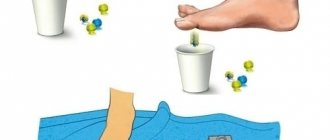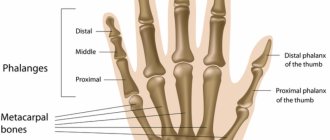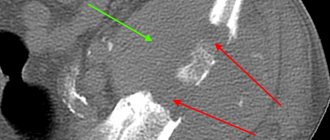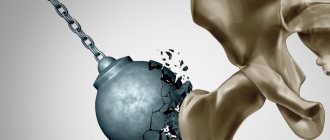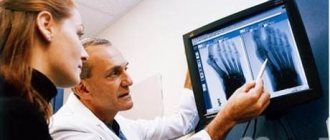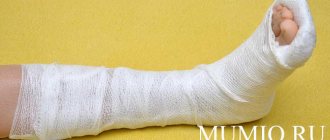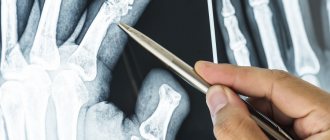After a fracture, a person has to wear a plaster cast for a long time so that a bone callus forms and the fragments grow together. This often brings a lot of inconvenience; due to prolonged immobilization, venous congestion occurs in the injured limb, and muscle atrophy develops. Today, medicine uses drugs to accelerate bone healing, improve blood circulation, and promote bone tissue restoration. Regular use of these products allows you to shorten the rehabilitation period and return to normal life in the shortest possible time.
Factors influencing bone recovery
After a fracture, the body needs a long time for bone fragments and muscles to heal, innervation and blood circulation to be restored. For some people, the regeneration process does not take much time, while for others it may take more than six months to fully restore limb function. Everything depends not only on the location of the fracture, but also on age and the presence of chronic diseases.
The duration of the rehabilitation period is influenced by the following factors:
- diameter of the damaged bone and type of fracture. Non-displaced injuries to the hand, forearm or foot heal fairly quickly. For fractures of the pelvis, humerus or femur, the patient must be in a cast for several months;
- time to provide first aid. The earlier pain relief and limb fixation were performed, the more favorable the prognosis;
- the risk of complications is significantly reduced if reposition of fragments with subsequent fixation is performed on the first day after the fracture;
- patient's age. In older people, blood circulation worsens, mineral metabolism is disrupted, as a result of which calcium is not completely absorbed. Therefore, the process of bone tissue regeneration takes much longer than in young people;
- general condition of the patient. Diabetes mellitus, tumor lesions of bones, vitamin deficiency, problems with the thyroid gland - this is an incomplete list of diseases for which the rehabilitation period can increase several times.
How to speed up the process of bone fusion?
In order to restore the functions of the damaged bone as quickly as possible, you must follow all the doctor’s recommendations. It is prohibited to perform physical exercises, massage, or take medications without consulting a traumatologist. This can lead to repeated displacement of fragments and improper fusion of bones.
Basic rules for successful rehabilitation:
- complete nutrition enriched with protein and calcium-containing foods. The diet should include a sufficient amount of fresh vegetables and fruits; you should also consume cottage cheese, cheese, eggs, fish and meat;
- moderate physical activity is indicated after the formation of a callus; only after a few weeks the doctor may allow you to perform the exercises;
- massage is indicated after removing the plaster. Regular sessions will help improve blood flow, reduce venous and lymphatic congestion;
- Medicines for fractures for rapid healing of bones are prescribed by the doctor according to strict indications. These could be calcium supplements, vitamins or chondroprotectors. Only a doctor can select the most effective group of drugs, dose and frequency of administration.
Preparations for fractures for rapid healing of bones
The success and speed of bone fusion is largely the responsibility of the person himself. The doctor may prescribe painkillers and anti-inflammatory drugs depending on the type and complexity of the fracture. However, other components are required for bone growth and strengthening.
The body needs the following substances for speedy recovery:
Minerals:
- calcium
- magnesium
- zinc
- phosphorus
Vitamins:
- vitamin C
- vitamin B6
- vitamin B12
- vitamin D
These components can be obtained from food, but medications containing these substances will not be superfluous. Calcium is the body's main helper in this situation. Therefore, calcium-containing tablets, for example, calcium gluconate, will come in handy. But remember that this substance is not absorbed without vitamin D. It is primarily found in fish oil. If its taste is unpleasant, there are medications with a combined composition containing both a mineral and a vitamin. Vitamin complexes should be taken if your diet is insufficiently varied.
You can remove the hematoma, improve blood circulation and numb the injured area after removing the plaster using ointment. For example, the Miracle Hash gel-balm, the main active components of which are chondroitin sulfate and glucosamine, not only relieves swelling and bruises near the joints, but also promotes the healing of bone tissue. Ointments and gels should only be applied to already healthy skin. Make sure in advance that you are not allergic to the components of the product.
Calcium preparations
Today, there are many drugs on the pharmacological market that contain calcium. It would seem that this microelement is an important component of bone tissue; taking calcium during a fracture will be beneficial, and the larger the dose, the better for a person. But it's not that simple. Firstly, in some preparations calcium is in a form that is poorly absorbed by the body. Secondly, it is necessary to strictly adhere to the dosage and periodically check the level of this trace element in the blood. After all, excess calcium leads to problems with the cardiovascular system and contributes to the formation of stones in the kidneys and gall bladder. Therefore, the choice of medicine must be approached with special attention.
Content
- Should I take calcium if I have a fracture?
- Calcium preparations for bone fractures
- What calcium supplements are best to take for bone fractures?
- Prevention of fractures
A fracture occurs when the pressure on a bone exceeds its load-bearing capacity.
There are conditions that weaken the bone (such as osteoporosis), and then a minimal impact is enough to cause a fracture. Among all injuries, bone fractures account for about 21.5%1. Healing of fractures is a critical physiological process that requires significant effort from the body. Improper fusion leads to severe dysfunction of the musculoskeletal system and deterioration in the quality of life. Rehabilitation after fractures takes from 5-6 weeks to a year or more. To speed up recovery, the body must receive a sufficient amount of calcium, which forms the basis of bone tissue in the form of hydroxyapatite.
Calcium gluconate
The drug is a monocomponent and is used to heal bones in fractures.
Available in the form of tablets and ampoules for injection. Features of application:
- The tablet must be taken before meals. The frequency of administration and dose should be determined by the doctor. In most cases, the drug is prescribed 3 times a day. The maximum daily dose for adults is 9g;
- calcium gluconate can be administered intramuscularly and intravenously in a hospital setting;
- for better absorption, it is recommended to take additional vitamin D3;
- during pregnancy and lactation, the drug is prescribed if the benefits of use are much higher than the possible risks. In this case, it is necessary to monitor the level of calcium in the blood.
Note! It is better to take calcium tablets with clean water. Coffee and tea impair the absorption of the active substance.
The most common side effects are constipation, nausea, vomiting, and stomach discomfort. As the dose increases, symptoms of hypercalcemia may develop: drowsiness, weakness, irritability, abdominal pain, vomiting, heart rhythm disturbances, increased blood pressure, muscle pain.
You can take medications containing calcium to heal bones during fractures only after consulting a doctor or after carefully reading the instructions. There are serious contraindications to the use of this group of drugs:
- intolerance to the components of the drug;
- tendency to form blood clots or severe atherosclerosis;
- increased concentration of calcium in the body;
- renal or liver failure.
- the presence of kidney stones.
Kalcemin
This drug contains not only calcium, but also vitamin D3, magnesium, zinc, copper and other trace elements. This combination improves the absorption of components in the intestines and helps the body absorb calcium.
Features of application:
- the medicine is available in tablets. The dose and frequency of administration are prescribed by the doctor. It is recommended for adults to take 1 tablet in the morning and evening; for children, 1 tablet per day is enough;
- Note! The drug contains vitamin D3, so there is no need to take it additionally, this can lead to an overdose;
- The main contraindications include hypercalcemia, allergies to the components of the drug, the presence of kidney stones, and an increased risk of blood clots;
- if after taking the drug nausea, vomiting, dizziness, or discomfort in the heart area occur, you should consult a doctor;
- Calcemin is allowed to be taken by pregnant women under medical supervision.
Calcium preparations for bone fractures
Three generations of drugs have been created for the treatment of injuries and diseases of the skeletal system:
Simple calcium salts (carbonate, citrate, lactate, gluconate, phosphate) are preparations that contain only one component. The bioavailability of calcium from them is relatively low, that is, a small amount of the mineral enters the bone tissue. To improve absorption, they must be combined with vitamin D3.
A combination of calcium salts (usually carbonate) and vitamin D. They do not solve all problems, since other microelements are needed to restore the elasticity and strength of bones4.
Calcium preparations with vitamin D, which include other minerals (magnesium, zinc, copper, manganese, boron). Examples are Calcemin® and Calcemin® Advance, which are prescribed for bone fractures in children and adults5. Such products provide not only an adequate dose of calcium and vitamin D, but also other important microelements that she has lost throughout her life3.
If a child or teenager has not achieved peak bone mass, they may be at increased risk of osteoporosis later in life. People who do not consume enough calcium-rich foods, such as dairy products, are also at risk.
Calcium-D3 Nycomed
Calcium-D3 Nycomed is prescribed for fractures for rapid healing of bones. Due to the fact that the composition includes calcium and vitamin D3, the drug is well absorbed in the gastrointestinal tract and is evenly distributed in the body. Taking this drug allows you to accelerate bone regeneration and replenish the deficiency of microelements.
Special instructions:
- the medicine is available in the form of chewable tablets with orange or mint flavor, which is especially popular with children;
- The frequency and duration of administration is prescribed by the doctor, depending on the severity of the patient’s condition and age characteristics. The average dose is 2-3 tablets per day;
- a significant advantage is that the drug can be taken regardless of food;
- There are almost no side effects. Calcium-D3 Nycomed is well tolerated by patients, reviews of the drug are positive;
- during pregnancy and lactation, the drug is prescribed by a doctor according to strict indications with subsequent monitoring of calcium in the blood.
Should I take calcium if I have a fracture?
Calcium enters the body only from the outside and, if there is a deficiency, is washed out of the bones so that its level in the blood remains unchanged. This is why the use of calcium greatly helps in the healing of fractures.
The regulation of calcium metabolism involves: - parathyroid hormones; - vitamin D, on which the absorption of the mineral in the intestine and its entry into bone tissue depends (with a lack of vitamin D, calcium is not absorbed and does not enter the bones in sufficient quantities: because of this, density decreases).
Balancing calcium and vitamin D is the basis for healthy bone formation. Research has shown that calcium supplements are effective in accelerating the healing of bone fractures,2 especially in osteoporosis. These agents improve the process of macroelement deposition in the bones and stimulate the formation of callus, an important stage in fracture healing.
Osteogenon
Osteogenon is one of the most effective drugs for bone fractures. It contains calcium and phosphorus, collagen, as well as non-collagen peptides. The main advantage of this remedy is that calcium is delivered directly to the bones, replenishing its deficiency, is not deposited in the kidneys, and does not aggravate urolithiasis.
Thanks to the special structure, the release of microelements occurs gradually. As a result, the risk of hypercalcemia and arrhythmias is minimal.
Main properties of Osteogen:
- regulation of calcium and phosphorus metabolism;
- stimulation of osteoblasts – bone tissue precursors;
- inhibition of osteoclast activity, thus the formation of new cells predominates in the bone;
- collagen and non-collagen peptides accelerate the regeneration process;
- Osteogenon promotes the formation of the mineral framework of the bone: calcium accumulates in the damaged area, making the tissue more dense.
To achieve results, the drug must be taken for a long time, on average 3-5 months. The daily dose and frequency of administration are determined by the doctor. It is recommended to take tablets for bone fractures 2 times a day.
Osteogenon is well tolerated by patients; it is contraindicated in the following cases:
- if you are intolerant to one of the components of the drug;
- in childhood;
- with increased levels of calcium in the body.
Products for bone healing
The vitamins and minerals identified above do not necessarily need to be obtained from third party sources. Their main supplier is food. In a state of rehabilitation, a balanced and varied diet is necessary. This is not so difficult, because the most ordinary, familiar food is rich in vitamins and minerals.
- Calcium, which is so necessary for healing bones, is found in fish, dairy products, cabbage and sesame.
- Sources of magnesium, which interacts with calcium, are bananas, shrimp, nuts, and wheat germ.
- Zinc can be obtained from sea fish and seafood.
- Phosphorus is required in small quantities. It can be found in cheese, buckwheat, and beef liver.
- Vitamin C helps keep calcium in the body. Citrus fruits and bell peppers are rich in it.
- Folic acid and vitamin B6 are involved in the formation of the bone frame. To do this, beets, bananas, cabbage, citrus fruits, beans, meat, fish and potatoes should be included in the diet.
- Vitamin B12 is essential for bone cells. It is found in lean meat, fish, and eggs.
- Vitamin D – absorbed from fish with bones, cheese and butter.
If you find it difficult to create a balanced diet for yourself and stick to it, you can use dietary supplements. The dietary supplement “Miracle Hash” contains chondroitin sulfate and glucosamine sulfate, which are necessary for the body, which have a beneficial effect on bones and relieve swelling.
Bone fusion will be favorably affected by adherence to the regime and moderate physical activity. But there are habits that you should break to achieve the fastest results.
The healing of a fracture is negatively affected by:
- smoking;
- alcohol consumption;
- drinks and products containing caffeine;
- excessive amounts of sweets.
Chondroitin
Drugs for rapid healing of bones during a fracture should be prescribed by a doctor. Even before purchasing vitamins or chondroprotectors, consultation with a specialist is necessary.
Chondroitin prevents further destruction of cartilage tissue, and is especially effective for intra-articular fractures. Active components promote the formation of collagen and hyaluron. Regular use of the product allows you to restore the metabolism of calcium and phosphorus and speed up the bone healing process.
The drug has several forms of release:
- capsules. You need to take the medicine for a long time, the effect occurs 2-3 months after starting treatment. The recommended dose for adults is 1 capsule 2 times a day (the intensive phase lasts 1 month), then switch to a maintenance dose - 1 capsule per day. Chondroitin is taken 20 minutes before meals;
- if necessary, the doctor may prescribe intramuscular injections. Injections are given every other day, the course of treatment averages 2 months;
- gel. A small amount of the drug should be applied to the skin at the fracture site and rubbed in a little. It is recommended to repeat the procedure daily for 2-3 months.
A promising approach to accelerated fracture therapy
Preliminary data suggests increased bone density, reduced toxicity and shorter recovery time
Every year in the United States alone, more than six million fractures are recorded , which results in billions of dollars in direct damage, not to mention indirect damage due to loss of ability to work.
The only drug available today that can speed up the process of bone healing should be applied directly to the fracture surface during surgery, but it is obvious that not every fracture requires such intervention. At the annual convention of the American Pharmaceutical Sciences Association on November 7, 2021, a review of preliminary results from a study on the effectiveness of a new anabolic drug was presented. Administered intravenously, the drug reduces the treatment time for a femur fracture by 60 percent without causing any impact on surrounding healthy tissue. Researchers from Purdue University (West Lafayette, Indiana, USA) have developed a new chemical formula - dasatinib-aspartate 10 conjugate, or DAC for short. The compound uses a targeted peptide combined with dasatinib, a known anti-cancer drug that has previously been found to stimulate bone growth. With the systematic introduction of DAC, its accumulation on the fracture surfaces was observed, which led to accelerated fusion and increased bone density. The results obtained indicate that the fusion process, which usually takes eight weeks until mechanical strength is completely restored, is reduced to three to four weeks when treated with this drug.
“We foresee significant demand for this new therapy,” said presenting author Mingding Wang. – Although surgery is not necessary for many fractures, in most cases the treatment process takes a long time, which can lead to complications, long-term disability, and in some cases even death. By developing a method for accelerated fracture repair without involving healthy bone or tissue, we hope to successfully overcome these problems."
The study results show that the optimal regimen for administering DAC is every other day , which is as effective as daily injections and results in a 114 percent increase in bone density. However, increasing the interval to four days already significantly reduces the potential effect. Because the blood supply to the fracture site is often compromised in the immediate post-injury period, it is advisable to wait one to two weeks until blood vessel function has stabilized before prescribing DAC; such an expectation does not negatively affect the effectiveness of the drug or the overall rate of healing processes.
The administration of non-targeted dasatinib also provided some acceleration of repair, but DAC was much more effective, especially in terms of increasing density. It should be noted, in addition, that even non-targeted dasatinib does not show significant toxicity when administered long-term to cancer patients. As for the new specialized conjugate, it is expected that it will be even safer; in other words, fracture surface-targeted dasatinib should be present in extremely low concentrations in other tissues.
Philip Lowe, principal investigator and Presidential Fellow at the Institute for Drug Development at Purdue University, said:
“While some cases may still require the use of splints, pins or wires, we hope that the benefits of the new therapy in speeding the return of fracture patients to normal function and lifestyle will be appreciated by the entire orthopedic community.”
The next phase of the study plans to provide evidence of the effectiveness of BAV for complex fractures, including long bone and femoral neck fractures, nonunion fractures (false joints), spinal fusion, and craniofacial fractures.
Based on materials from the Science Daily website

